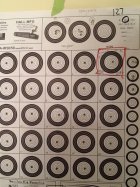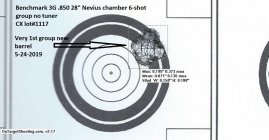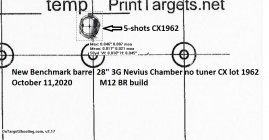From a person with some experience Tim, what do you directly think is different RF to CF to cause you to be so sure of this? I am asking for your thoughts on this, not you stating Gordon Eck or someone else. I understand an IR sporter too and why that is such an easy thing to cling to in this argument. If they were the end all be all to the argument, why does anyone build 10.5/13.5 Lb guns at all that participate in IR? It would be a hell of a lot easier to work with one gun all the time than to try to to keep 2 going. There are scope choices being used now that can get around the 6.5X limit in sporter for the other two classes as well.
I used to be in your camp and think there was no correlation but after willingly and actually open-minded tested enough to to actually tell, I found out I was wrong. The same things are going on just at a little different timing and intensity. I got better and my equipment got better too. Just like basic tuning in general, you will likely not see anything if all you do is adjust willy-nilly and hope for something. It takes work to make it happen and figure out. Things evolve in 20 years, even if the people along for the ride kick and scream the whole way.
Tad
Tad, my thoughts, but understand, at best these are ( both yours and mine) but, educated guesses. RF interior ballistics is for all it’s worth, still pretty subjective in many ways and my thoughts are my own, well before I started using Gordon, The smith I used for years was a sharp cookie and did tremendous work on harmonics and tuning even developing triangular barrel profiles to change and minimize vibrations.
As to Sporters, several guys shoot them for all 3 gun, but the plain simple truth is heavier is easier, 3” forends beat 2”, and even with a variable, youvare quite below ideal scope power.
You guys have stated lots of guys bring multiple lots to the bench for sporter but simply rarely happens.
Certainly, barrel harmonics are similar, sine waves, etc but, I suspect the biggest
difference is the magnitude and the initial pressure curves involved.
Everybody knows, for instance, in CFBR shooting N133, you may very well have to chase load throughout a match for whatever reason, BUT, rarely if ever if you shoot LT 32, or LT 30.
I have won with 133, pretty familiar with it, I have won with LT 32 and never change load, when first on the scene Lou Murdica shot the same load of LT for a whole damn year and won plenty. In our weekly club matches, 100yds, 200yds, I shot LT30 all year…same load…never moved it a tenth, shot same, winter and summer, dead of last winter, shot a .1650 agg, You tell me why 133 you play with LT 32, 30, virtually never.
RF while exhibiting similar characteristics is dealing with far less intensity, especially in two areas…..initial combustion and final distance before exit of the slug.While similar, everything in RF is less/slower allowing for a lasting tune….The variances are smaller.
The best….very best barrels, that seal well allow the slug to exit in a far less exited state than CF. The old timers used to say the best barrels wii put a slug to sleep before exit.
I have been very fortunate to have some wonderful barrels, chambered correctly and my beliefs pertain to that class of barrels which are less common, even today, than many believe and one of the single biggest challenges in RFBR is the ability to score one as well as recognize one.
Everything is better with a barrel like that, a flat shooting one, and with great ammo it’s tuned for keeps.
Certainly I’ve played with tune in different atmospheric condition….always go back to my tune. Here’s a card shot in a match a while back.Tune same as it was 6 years before. I think you’d agree, that’s a damn flat shooting rifle.
Even with the best testing discipline, there are so many variables involved, we’re still relegated, at the end, to educated guesswork.
My big frustration is these gurus with about a years worth of experience giving “definitive” answers to lots of this stuff, and the hapless newbies inclined to follow them toward frustration to no end. My thoughts, but my own developed over a hell of a long time doing this with a pretty fair track record.
Best,
Tim













